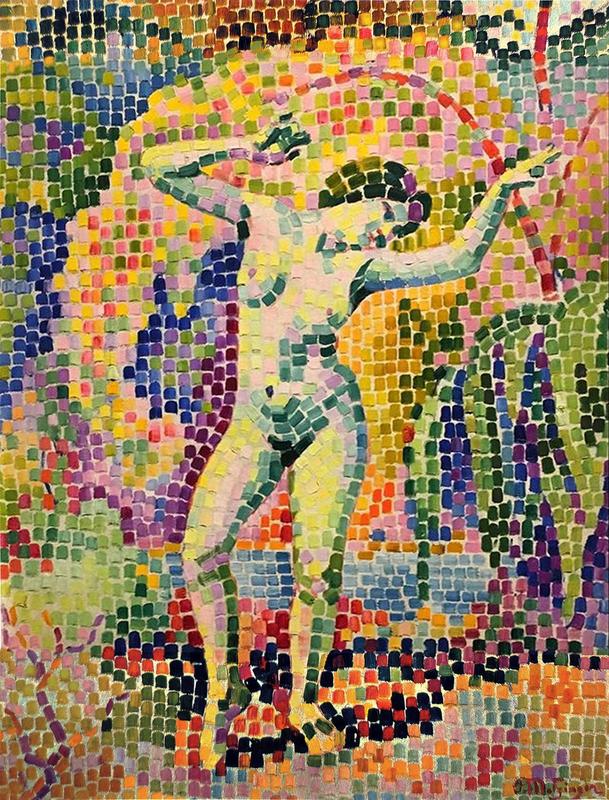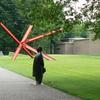More about Bacchante

Contributor
Metzinger's La Danse, also known as Bacchante, shows the artist on the road to cubism, playing with the bright, cheery colors of Fauvism and the pixelated look of "divisionism."
The art historian Max Raphael came at Metzinger sideways, claiming that he and Delaunay ripped off the styles of Signac and Picasso in order to make money. Calling Metzinger "ambitious" but "impotent," Raphael imagined the following inner-mind monologue: "Picasso doesn't exhibit his work, and if he were to get known, then I, Monsieur Metzinger, will curse him out of existence." Picasso laughed about this, all the way to the bank.
A former mathematician, Metzinger wanted to create a "purely mathematical" process of painting, which, in this work, involves dividing the canvas into segments, like a digital image. The image takes advantage of pareidolia, a neurological phenomenon that allows us to recognize forms based on the imagination. In cases of pareidolia, it is easier to recognize something with a more limited range of input, so if you want to see it really clearly, squint first. Both Braque and Metzinger worked with the Fauve idiom of Matisse and Derain, on their way to cubism. Three years after meeting Picasso, Metzinger wrote an article which identified a connection between Picasso, Braque, Delaunay, and Le Fauconnier. Only later did other writers look back and call this "cubism."
La Danse, Bacchante is an installation in an ancient tradition of pre-Christian Greece. The Bacchante, or the Bacchae, or maenads, go by many names, and they are connected to the artistic tradition of nymphs and fairies. They are, in some cases, women who initially resisted the tempting attraction of Bacchus, A.K.A. Dionysus, the deity of drunkenness, intoxication, trance, and hypnosis. In other cases, they follow him willingly. They throw off all reason, and submit themselves completely to Bacchus. In exchange for their devotion, Bacchus nullifies their politeness, and they go hog wild, ripping people and animals apart with their bare hands. This image of hypnotic swarms of women punishing men for our arrogance and lack of spiritual devotion was quite popular. The "dance" of the Bacchante puts her in a pose like The Source by Ingres. Because there were not yet all-you-can-eat highway restaurants with big laminated menus, people had to work harder to find their food. But not the Bacchantes—conveniently, they had the ritual of omophagia, which is their word for eating live raw flesh, one of their favorite ways to pass the time. Omophagia makes the whole country into an all-you-can-eat buffet. These activities were part of the "mystery" stories, but not the cult itself.
Sources
- Amital, R. Yehuda. Jewish Values in a Changing World. Jersey City, NJ: KTAV, 5675/2005.
- Cottington, David. Cubism and Its Histories. Manchester: Manchester University Press, 2004.
- Oranje, Hans. Euripides & Bacchae. Leiden: Brill, 1984.
- Richardson, John. A Life of Picasso. New York: Knopf, 2007.
Featured Content
Here is what Wikipedia says about La danse, Bacchante
La danse (also known as Bacchante) is an oil painting created circa 1906 by the French artist and theorist Jean Metzinger (1883–1956). Bacchante is a pre-Cubist or Proto-Cubist work executed in a highly personal Divisionist style during the height of the Fauve period. Bacchante was painted in Paris at a time when Metzinger and Robert Delaunay painted portraits of one another, exhibiting together at the Salon d'Automne and the Berthe Weill gallery. Bacchante was exhibited in Paris during the spring of 1907 at the Salon des Indépendants (No. 3460), along with Coucher de soleil and four other works by Metzinger.
The painting was purchased by the art historian and collector Wilhelm Uhde and formed part of his collection until it was sequestered by the French government just before World War I. By 30 May 1921 Bacchante was owned by the French painter André Lhote. The painting appeared at the auction house Hôtel Drouot where it was presumably purchased by Kröller-Müller, and published in Catalogue of the paintings in the collection of Helene Kröller-Müller. The painting forms part of the permanent collection of the Kröller-Müller Museum.
Check out the full Wikipedia article about La danse, Bacchante













This art work called The Cult of Drunkness is filled with many different colors; all colors of the rainbow. Hidden in the work are many little shapes of squares filling up the design, all different colors. These different colors and shapes bring alive the image of a naked women which is being portrayed in the middle.